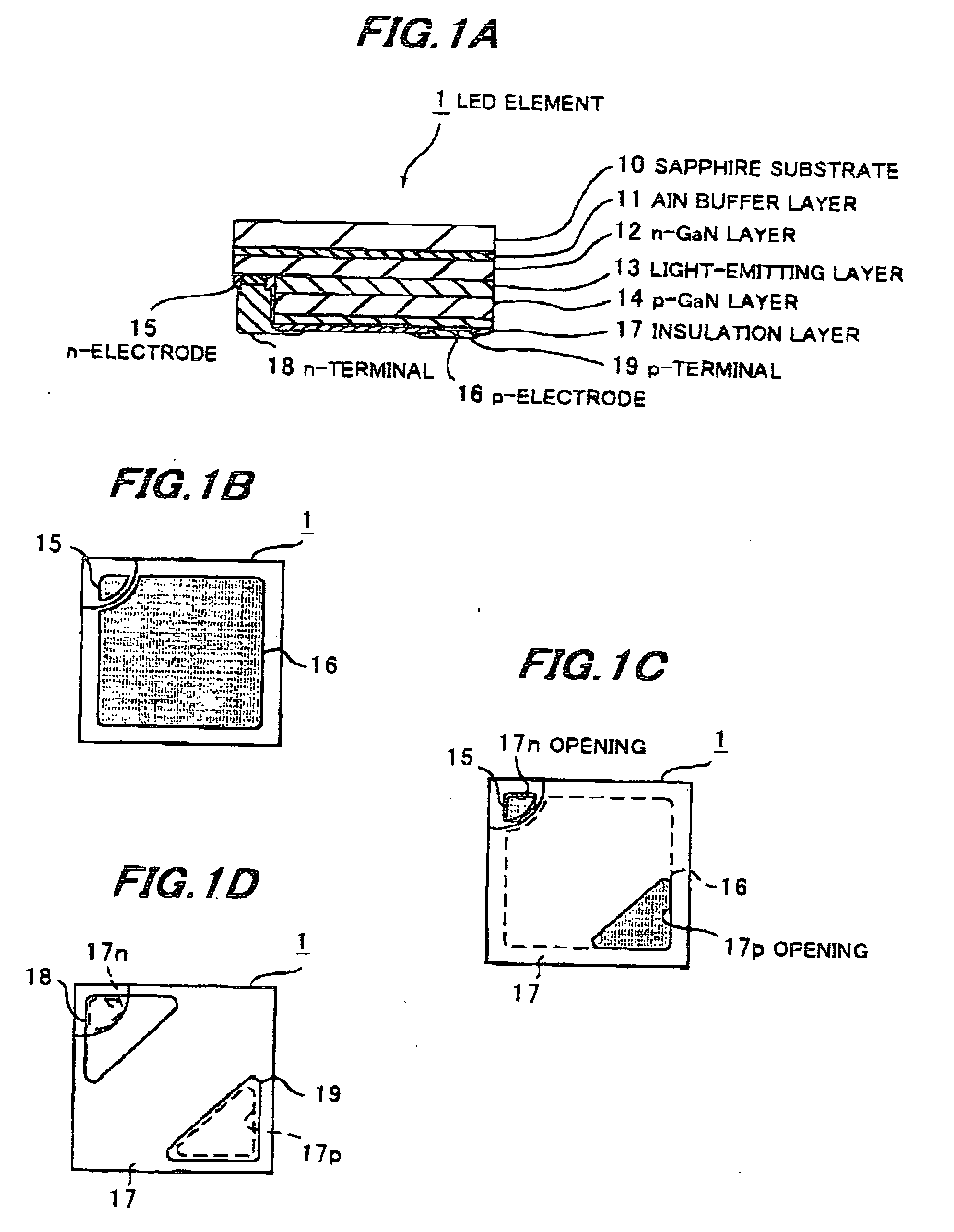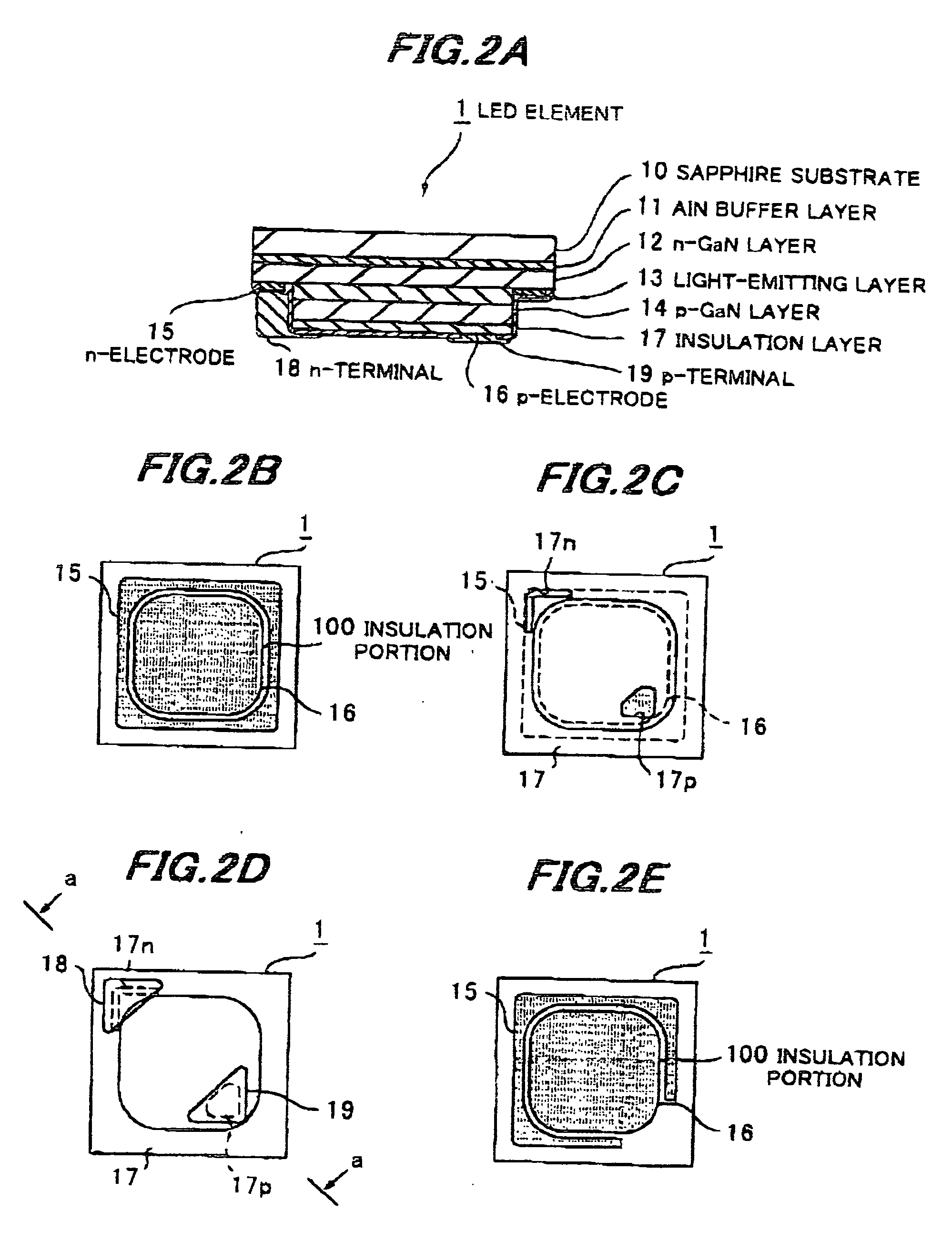Light emitting element and method of making same
a technology of light-emitting elements and light-emitting elements, which is applied in the direction of basic electric elements, semiconductor devices, electrical equipment, etc., can solve the problems of large current that cannot be applied thereto, difficult to enhance brightness or improve light-emitting, and non-uniform light patterns, etc., to achieve increased emission area, increase brightness thereof, and prevent uneven light-emitting patterns
- Summary
- Abstract
- Description
- Claims
- Application Information
AI Technical Summary
Benefits of technology
Problems solved by technology
Method used
Image
Examples
first embodiment
(Composition of LED Element 1)
[0090]FIGS. 1A to 1D show an LED element in the first preferred embodiment according to the invention.
[0091] The LED element 1 is composed of: a sapphire substrate 10; an AlN buffer layer 11 formed on the sapphire substrate 10; an n-GaN layer 12 formed on the AlN buffer layer 11; a light-emitting layer 13 formed on the n-GaN layer 12; a p-GaN layer 14 formed on the light-emitting layer 13, the n-GaN layer 12 to the p-GaN layer 14 being of group III nitride-based compound semiconductor; an n-electrode 15 as a second electrode formed on part of the n-GaN layer 12 exposed by partially etching the p-GaN layer 14 to the n-GaN layer 12; a p-electrode 16 as a first electrode formed on the p-GaN layer 14 to supply current to the light-emitting layer 13; an insulation layer 17 of a SiO2-based material formed to cover the electrode formation side; an n-terminal 18 electrically connected through an opening 17n provided in the insulation layer 17 to the n-electr...
second embodiment
(Composition of LED Element 1)
[0113]FIGS. 2A to 2D show an LED element in the second preferred embodiment according to the invention.
[0114] Herein, like components are indicated by the same numerals as used in the first embodiment.
[0115] The flip-chip type LED element 1 is different from the first embodiment in that, as shown in FIG. 2A, the p-GaN layer 14 is disposed like an island at the center of the LED element 1, the p-electrode 16 is formed thereon, and the n-electrode 15 is disposed circularly around the p-electrode 16.
[0116] The n-electrode 15 is about 10 μm in line width of narrowest portion and about 350 μm in line width of widest portion. The p-electrode 16 is, as shown in FIG. 2B, shaped like a square with rounded corners, and a predetermined distance separated through an insulation portion 100 from the n-electrode 15 which circularly surrounds the p-electrode 16. The predetermined distance is preferably such a minimum one that can prevent the light leakage from the...
modification 1
(Modification 1 of Electrode Form)
[0125] As shown in FIG. 3A, the n-electrode 15 may have a separation portion 150 that diagonally separates the p-electrode 16.
[0126] In modification 1, since the formation region of the p-electrode 16 is separated into two parts, current can be uniformly and rapidly spread and thereby good emission characteristics can be obtained under the p-electrode 16
PUM
 Login to View More
Login to View More Abstract
Description
Claims
Application Information
 Login to View More
Login to View More - R&D
- Intellectual Property
- Life Sciences
- Materials
- Tech Scout
- Unparalleled Data Quality
- Higher Quality Content
- 60% Fewer Hallucinations
Browse by: Latest US Patents, China's latest patents, Technical Efficacy Thesaurus, Application Domain, Technology Topic, Popular Technical Reports.
© 2025 PatSnap. All rights reserved.Legal|Privacy policy|Modern Slavery Act Transparency Statement|Sitemap|About US| Contact US: help@patsnap.com



